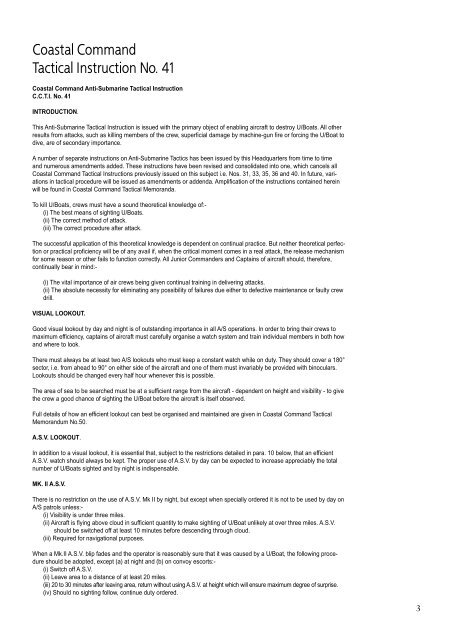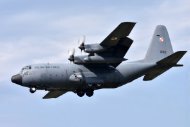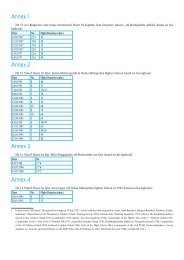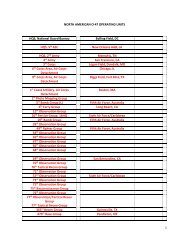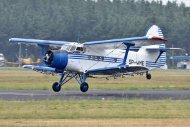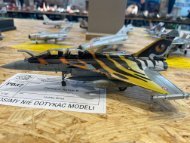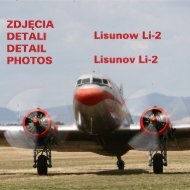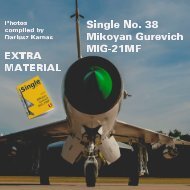B-17 CC Additional Material by Robert M Stitt
Boeing B-17 Fortress in RAF Coastal Command Service Second Edition Robert M Stitt Additional Material
Boeing B-17 Fortress in RAF Coastal Command Service
Second Edition
Robert M Stitt
Additional Material
- No tags were found...
Create successful ePaper yourself
Turn your PDF publications into a flip-book with our unique Google optimized e-Paper software.
Coastal Command<br />
Tactical Instruction No. 41<br />
Coastal Command Anti-Submarine Tactical Instruction<br />
C.C.T.I. No. 41<br />
INTRODUCTION.<br />
This Anti-Submarine Tactical Instruction is issued with the primary object of enabling aircraft to destroy U/Boats. All other<br />
results from attacks, such as killing members of the crew, superficial damage <strong>by</strong> machine-gun fire or forcing the U/Boat to<br />
dive, are of secondary importance.<br />
A number of separate instructions on Anti-Submarine Tactics has been issued <strong>by</strong> this Headquarters from time to time<br />
and numerous amendments added. These instructions have been revised and consolidated into one, which cancels all<br />
Coastal Command Tactical Instructions previously issued on this subject i.e. Nos. 31, 33, 35, 36 and 40. In future, variations<br />
in tactical procedure will be issued as amendments or addenda. Amplification of the instructions contained herein<br />
will be found in Coastal Command Tactical Memoranda.<br />
To kill U/Boats, crews must have a sound theoretical knowledge of:-<br />
(i) The best means of sighting U/Boats.<br />
(ii) The correct method of attack.<br />
(iii) The correct procedure after attack.<br />
The successful application of this theoretical knowledge is dependent on continual practice. But neither theoretical perfection<br />
or practical proficiency will be of any avail if, when the critical moment comes in a real attack, the release mechanism<br />
for some reason or other fails to function correctly. All Junior Commanders and Captains of aircraft should, therefore,<br />
continually bear in mind:-<br />
(i) The vital importance of air crews being given continual training in delivering attacks.<br />
(ii) The absolute necessity for eliminating any possibility of failures due either to defective maintenance or faulty crew<br />
drill.<br />
VISUAL LOOKOUT.<br />
Good visual lookout <strong>by</strong> day and night is of outstanding importance in all A/S operations. In order to bring their crews to<br />
maximum efficiency, captains of aircraft must carefully organise a watch system and train individual members in both how<br />
and where to look.<br />
There must always be at least two A/S lookouts who must keep a constant watch while on duty. They should cover a 180°<br />
sector, i.e. from ahead to 90° on either side of the aircraft and one of them must invariably be provided with binoculars.<br />
Lookouts should be changed every half hour whenever this is possible.<br />
The area of sea to be searched must be at a sufficient range from the aircraft - dependent on height and visibility - to give<br />
the crew a good chance of sighting the U/Boat before the aircraft is itself observed.<br />
Full details of how an efficient lookout can best be organised and maintained are given in Coastal Command Tactical<br />
Memorandum No.50.<br />
A.S.V. LOOKOUT.<br />
In addition to a visual lookout, it is essential that, subject to the restrictions detailed in para. 10 below, that an efficient<br />
A.S.V. watch should always be kept. The proper use of A.S.V. <strong>by</strong> day can be expected to increase appreciably the total<br />
number of U/Boats sighted and <strong>by</strong> night is indispensable.<br />
MK. II A.S.V.<br />
There is no restriction on the use of A.S.V. Mk II <strong>by</strong> night, but except when specially ordered it is not to be used <strong>by</strong> day on<br />
A/S patrols unless:-<br />
(i) Visibility is under three miles.<br />
(ii) Aircraft is flying above cloud in sufficient quantity to make sighting of U/Boat unlikely at over three miles. A.S.V.<br />
should be switched off at least 10 minutes before descending through cloud.<br />
(iii) Required for navigational purposes.<br />
When a Mk.II A.S.V. blip fades and the operator is reasonably sure that it was caused <strong>by</strong> a U/Boat, the following procedure<br />
should be adopted, except (a) at night and (b) on convoy escorts:-<br />
(i) Switch off A.S.V.<br />
(ii) Leave area to a distance of at least 20 miles.<br />
(iii) 20 to 30 minutes after leaving area, return without using A.S.V. at height which will ensure maximum degree of surprise.<br />
(iv) Should no sighting follow, continue duty ordered.<br />
3


